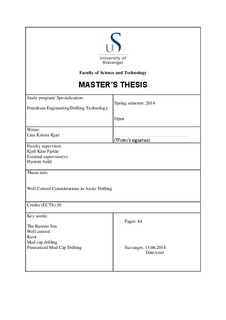| dc.contributor.author | Kjær, Linn Kristin | |
| dc.date.accessioned | 2014-09-22T12:28:21Z | |
| dc.date.available | 2014-09-22T12:28:21Z | |
| dc.date.issued | 2014-06-13 | |
| dc.identifier.uri | http://hdl.handle.net/11250/220904 | |
| dc.description | Master's thesis in Petroleum engineering | nb_NO |
| dc.description.abstract | As the petroleum industry is in a constant move north for new exploration and production areas, both challenges and opportunities are many. The vast majority of the northern hemisphere are characterized by low temperatures, darkness, ice and great distances which makes any drilling operation more complicated and therefore precise measures and solutions need to be in place to prevent problems from arising. This is the case for the Norwegian part of the Barents Sea where petroleum activities has been ongoing for decades but is still relatively underdeveloped with only one field in production. The Barents Sea could be looked at as an extension of the harsh Norwegian Sea and additionally has the Arctic weather phenomena’s such as polar lows and snow storms.
Well control is always of great concern in a drilling operation and it should be just as safe and secure in the Barents Sea as the rest of the Norwegian Continental Shelf (NCS). It is in this thesis tried to identify specific risks and precautions related to a drilling operation in the Barents Sea based on environmental conditions and recent findings, as it is expected to be the new phase of petroleum production in Norway in the years to come.
There is a general environmental concern with undertaking drilling in the Barents Sea areas as these locations are pristine and vulnerable to a potential oil spill. More specific challenges are related to the choice of an appropriate drilling unit and the limited number of winterized rigs available if a blow-out should occur and there is a need for relief well drilling. Hydrate formation in well control equipment both topside and subsea is a possible threat to create an unwanted situation. The main focus in this thesis is put towards recent findings of a karst reservoir at Gotha which is located in the Barents Sea. This is the first time there is proven economic viability of such a reservoir in Norway, a reservoir type which has a history of being complicated and costly to drill due to severe losses of circulation leading to non-productive time (NPT). A study of what karst are, how it is formed and the difficulty to both map and drill this geologic feature is included in this thesis. A possible solution to the drilling issues in karst is implementation of the managed pressure drilling (MPD) version pressurized mud cap drilling (PMCD), which is not yet a recognized drilling technique in Norway.
By looking at what is done up to date and comparing with the plans for the Barents Sea in the future it is clear that an accurately planning process is essential for successful operations. The planning process requires close cooperation between the industry and the authorities to enable PMCD on the NCS as well as regards to procedures, HSE, equipment and proper training of personnel. | nb_NO |
| dc.language.iso | eng | nb_NO |
| dc.publisher | University of Stavanger, Norway | nb_NO |
| dc.relation.ispartofseries | Masteroppgave/UIS-TN-IPT/2014; | |
| dc.rights | Attribution-NoDerivs 3.0 Norway | * |
| dc.rights.uri | http://creativecommons.org/licenses/by-nd/3.0/no/ | * |
| dc.subject | petroleumsteknologi | nb_NO |
| dc.subject | karst | nb_NO |
| dc.subject | Barentshavet | nb_NO |
| dc.subject | well control | nb_NO |
| dc.subject | pressurized mud cap drilling | nb_NO |
| dc.title | Well control considerations in Arctic drilling | nb_NO |
| dc.type | Master thesis | nb_NO |
| dc.subject.nsi | VDP::Technology: 500::Rock and petroleum disciplines: 510::Petroleum engineering: 512 | nb_NO |

